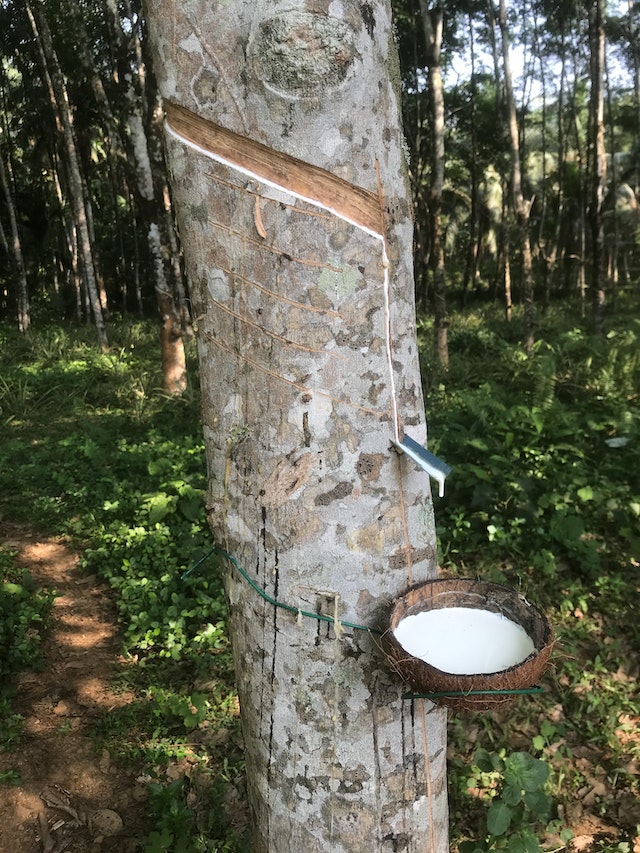
Why do some trees make rubber? It protects the trees against pests and helps them heal when they are injured.
Rubber is not what comes out of the tree or plant. The liquid that is tapped out of the tree is called latex and it has to be refined before it can be used as rubber. Approximately 10% of all plants produce latex although most of the world’s natural rubber comes from the Amazonian rubber tree (Hevea brasiliensis). This is the tree most often used because it is the easiest to cultivate.
Latex is a thick, creamy white, milky liquid. Sometimes it is clear, yellow, or orange, but white is the most common. It is an emulsion, which means it is a mix of two or more liquids that normally do not mix, such as a salad dressing. One of the liquids is suspended in the other. In this case, it is a mix of polymers suspended in water. Polymers are large molecules made up of chains of connected atoms. Each link in the chain is called a monomer. Latex also contains proteins, alkaloids, starches, sugars, oils, tannins, resins, and gums.
Latex is different to sap, which is the water, sugar, and plant nutrients that travel through the plant from the leaves to the roots. It is also different to the sap that becomes maple syrup. Plants make latex in special cells that are called laticifers. Inside the plant there is a system called the laticiferous system. Many cells that are close to each other join together. Their cell walls dissolve, creating long tubes that are called latex vessels. The latex is produced by the plant and carried near to the surface through these latex tubes. Some plants have a more complex system where the laticiferous system branches throughout them, but rubber trees have a much simpler system. The latex runs underneath the surface of the plants and under the bark of the tree. When the tree is cut or injured, the latex flows out of the wound. This is how it can be tapped. It takes about ten years before a rubber tree produces enough latex to be tapped.
So, why do plants produce latex? The first reason is to heal themselves and seal up their wounds. One of the reasons humans use latex is because it hardens on contact with air and becomes very rubbery and sticky. If a tree is cut, latex will flow to the wound from other parts of the tree. When the latex fills the wound, it starts to set. This seals up the wound, protecting the inside of the tree, and it can also trap any insects that are trying to feed there. The hardening latex also stops bacteria or viruses from getting into the softer part of the tree and causing disease or damage.
The second reason is that it is a pesticide. It varies from plant to plant, but latexes appear to contain toxins and pesticides. Experiments have shown that slugs will eat leaves that are drained of latex, but they won’t touch leaves that still contain latex. Several types of insects that feed on trees also try to cut the latex tubes before they feed on the tree. Some leaves containing latex are highly toxic to insects. As will always happen, there are insects that have evolved to be able to eat the leaves. The mulberry tree produces a latex that is highly toxic to all caterpillars, except for the silkworm, which lives quite happily on the tree.
When latex is tapped from a rubber tree, a spout is put into the bark and the latex flows to seal the wound, pouring out of the spout and into a collecting bucket. Trees are tapped in the early morning because their internal pressure is higher and this pushes the latex out more easily. Rubber trees are usually tapped every three days to give them time to replenish. A rubber tree can produce rubber for over 30 years.
There is actually a shortage of rubber in the world at the moment. About 40% of the world’s rubber comes from natural sources and the other 60% is synthetic. However, the COVID virus situation created a huge demand for latex gloves and the demand for rubber skyrocketed. At the same time the price of oil has gone up so much that synthetic rubber is becoming very expensive. Climate change is also having an impact on the health of the rubber trees and how much rubber they can produce. Altogether, there is a lot of concern about whether it is possible to meet the world’s latex requirements. And this is what I learned today.
Photo by Terance Kaluthanthiri: https://www.pexels.com/photo/a-bowl-collecting-rubber-milk-9529001/
Sources
https://www.pnas.org/doi/10.1073/pnas.0506944103
https://www.thedailygarden.us/garden-word-of-the-day/latex
https://www.treehugger.com/where-does-latex-come-from-3269790
https://www.fs.usda.gov/wildflowers/ethnobotany/latex.shtml
https://kids.frontiersin.org/articles/10.3389/frym.2019.00100
https://lipidlibrary.aocs.org/chemistry/physics/plant-lipid/rubber-biosynthesis-in-plants
https://en.wikipedia.org/wiki/Natural_rubber
https://en.wikipedia.org/wiki/Latex
https://www.riken.jp/en/news_pubs/research_news/pr/2016/20160624_1/
